Multivariate Statistical Analysis and Structural Sovereignty for Geochemical Assessment and Groundwater Prevalence in Bahariya Oasis, Western Desert, Egypt
Abstract
1. Introduction
2. Study Area
2.1. Geological Setting
- The Precambrian basement is made up mostly of igneous and metamorphic rocks (1391–1718 m) [19];
- Intercalated siltstone, sandstone, and clay constitute 458 m-thick Cambrian rocks;
- Cretaceous rocks: 660 m from the bottom to the top, and there are four formations:
- (a)
- The Bahariya Formation (Lower Cenomanian). This formation is made up primarily of flat-lying fluviatile sandstone and it serves as the oasis’s floor (total: 705 m thick, with a maximum exposed thickness of 173.5 m). The Bahariya Formation is marked by abundant intercalations of ferruginous layers [20,21].The thickness of the Bahariya Formation ranges from 90 m in the central section of the depression, to more than 170 m in the northern parts (Gabal El Dist) (Figure 3d). It displays a portion of the Bahariya Formation (Cenomanian, Upper Cretaceous) and is overlain by the Naqb Formation (Middle Eocene). In the Sandstone Hills region and at Gabal Miteilaa Radwan, the lower sandstone member is well exposed. In the northeastern scarps, the Bahariya Formation is surmounted by Middle Miocene basaltic rocks at Gabal El-Hefhuf.The Black Desert is located 50 km south of El-Bawiti, is composed of conical-shaped mountainous hills, and is fundamentally related to the Bahariya Formation (Cenomanian ferruginous sandstone and chalky clays). The majority of these hills are covered with ironstones and dolerite crystals (Figure 3e);
- (b)
- The El-Heiz Formation (Upper Cenomanian). This formation, which is unconformably topped by the El-Hefhuf Formation, is composed primarily of fossiliferous limestone, shale, calcareous sandstone, and marl (Figure 3f) [19,22,23]. The El-Heiz Formation reaches a maximum thickness of 40 m in the southern part of the depression at Naqb El Sellem, and then drops to around 12 m in the northern scarp;
- (c)
- The El-Hefhuf Formation (Campanian–Turonian). This formation is a 130 m-thick succession of light-brown siliceous dolomite, dolomitic limestone, and sandstone, and it unconformably superimposes the El-Heiz Formation (Figure 3g) near Gabal El-Hefhuf [24]. At the Bahariya north scarp, the El-Hefhuf Formation is absent, and the Bahariya Formation is unconformably overlain by Lower Eocene limestones [25]);
- (d)
- Paleocene rocks are clearly identified by: (a) The Tarawan Chalk (20–30 m thick), which is composed essentially of chalky limestone and limestone and which is naked to the south of the depression; and (b) The Esna Shale, which is featured in the plateau’s southern escarpment (Figure 3h), separating the Bahariya and El-Farafra depressions [19,23]);
- Eocene rocks. They constitute the Farafra and Nqab formations and represent the top of the plateau that surrounds the Bahariya depression:
- (a)
- The Farafra Formation (Lower Eocene), which is featured in the eastern and southern escarpments of the depression. Only the upper member of the Farafra Formation is visible;
- (b)
- The Naqb Formation, which mainly comprises pink to violet Nummulitic dolostone and limestone accumulations (Figure 3i). Iron ore deposits have emerged in the northeastern Bahariya Depression (the El-Gedida, Gabal Ghorabi, Nasser, and El-Harra districts), where iron-bearing solutions have substituted the Naqb’s carbonate rock [28]);
- (c)
- The Qazzun Formation, which is constituted of chalky Nummulitic limestones with firm dolomitic-limestone ball-like concretions (7–10 km-wide band);
- (d)
- The El-Hamra Formation (Middle-Upper Eocene), which is on the eastern plateau of the depression (63 m of fossiliferous limestone deposits) [29];
- Tertiary rocks comprise: (a) Volcanic rocks. Numerous isolated basalt outcrops in the northern and central parts of the depression (Measera, Mandisha, El-Hefhuf, and Basalt Hills), sheets of Oligocene-aged volcanic rocks, and mainly extrusive basalt and dolerite cap the sedimentary deposits (Figure 3j,k). A WNW-oriented dolerite dike and a thin laccolith may be seen at Gabal El-Hefhuf; (b) Ferruginous grits and layers of sandstone and clayey sandstone constitute the Radwan Formation [19,25,29]); (c) The Qatrani Formation (Oligocene) is found in the northeastern plateau and represents the weathering products of various Cretaceous and Eocene rock groups;
- Quaternary rocks include: (a) aeolian sands, forming dispersed seif dunes; (b) sabkhas and salt deposits, established owing to the infiltration of water from naturally flowing springs and wells on the depression surface; (c) playa deposits, which are made up mostly of fine sand, silt, clay, gypsum, and halite, and are found in freshwater depressions.
| Age | Rock Unit | Thickness (m) | Lithology |
|---|---|---|---|
| Quaternary | Gravel terraces, talus, sabkha and playa deposits, wind-blown sand, and alluvium | ||
| Early Miocene (16–20 Ma) | Basalt flows and sills | 20 | Olivine basalt |
| Oligocene | Qatrani Formation | Weathering products of the different rock units of Cretaceous and Eocene ages and occurs in the northeastern plateau | |
| Oligocene | Radwan Formation | 40 | Ferruginous grits and beds of pale-brown to yellow sandstone and clayey sandstone |
| Unconformity | |||
| Middle and Late Eocene | El-Hamra Formation | 63 | Fossiliferous limestone beds with a few clastic intercalations with inward dips of 10–40° |
| Middle Eocene | Qazzun Formation | 32 | Chalky Nummulitic limestones with ball-like concretions of hard dolomitic limestone |
| Unconformity | |||
| Middle Eocene | Naqb Formation(Ghorabi iron ore member) | 68 | Pink to violet Nummulitic dolostone and limestone forming isolated hills |
| Lower Eocene | Farafra Formation | 34 | Limestone |
| Upper Paleocene–Lower Eocene | Esna Shale | 20 | Greenish-gray to gray shale |
| Lower Paleocene | Tarawan Chalk | 20–30 | Chalky limestone and limestone |
| Unconformity | |||
| Early Maastrichtian | Khoman Chalk | 30–45 | Massive white chalky limestones |
| Campanian | El-Hefhuf Formation | 120 | Dolostone and sandstone with sandy clay intercalations |
| Unconformity | |||
| Late Cenomanian | El-Heiz Formation | 30 | Clastics with carbonate interbeds and a dolostone member at the top |
| Cenomanian | El-Bahariya Formation | 170+ | Variegated, cross-bedded sandstone |
| Cambrian | Cambrian rocks | 458 | Intercalated siltstone, sandstone, and clay |
| Pre-Cambrian | Metamorphosed igneous basement |
2.2. Structural Setting
2.3. Hydrogeological Setting
3. Methodology
3.1. Sampling and Analysis
3.2. Geostatistical and Geochemical Modeling
3.3. Multivariate Statistical Analysis
4. Results and Discussion
4.1. Groundwater Flow Pattern
4.2. Hydrochemical Characteristics
4.3. Hydrogeochemical Facies
4.4. Geochemical Processes and Groundwater Evolution
4.4.1. Dissolution and Weathering
4.4.2. Ion Exchange
4.5. Groundwater Parameter Interrelationships
4.5.1. Pearson Coefficient
4.5.2. Factor Analyses
5. Conclusions
Author Contributions
Funding
Institutional Review Board Statement
Informed Consent Statement
Data Availability Statement
Conflicts of Interest
References
- MWRI. Water for the Future; National Water Resources Plan for Egypt 2017; Planning Sector of Ministry of Water Resources and Irrigation: Cairo, Egypt, 2005. [Google Scholar]
- ARDC (Agricultural Research and Development Council). Sustainable Agricultural Development Strategy Towards 2030; Ministry of Agriculture and Land Reclamation: Cairo, Egypt, 2009. [Google Scholar]
- Foster, S.; Loucks, D. Non-Renewable Groundwater Resources; IHP-VI, Series on Groundwater, No. 10; UNESCO: Paris, France, 2006; p. 81. [Google Scholar]
- Amjath-Babu, T.; Krupnik, T.J.; Kaechele, H.; Aravindakshan, S.; Sietz, D. Transitioning to groundwater irrigated intensified agriculture in Sub-Saharan Africa: An indicator based assessment. Agric. Water Manag. 2016, 168, 125–135. [Google Scholar] [CrossRef]
- Langmuir, D. Aqueous Environmental Geochemistry; No. 551.48 L3; Pearson Education: London, UK, 1997; ISBN 9780023674129. [Google Scholar]
- Apollaro, C.; Marini, L.; De Rosa, R. Use of reaction path modeling to predict the chemistry of stream water and groundwater: A case study from the Fiume Grande valley (Calabria, Italy). Environ. Earth Sci. 2007, 51, 1133–1145. [Google Scholar] [CrossRef]
- Fuoco, I.; Marini, L.; De Rosa, R.; Figoli, A.; Gabriele, B.; Apollaro, C. Use of reaction path modelling to investigate the evolution of water chemistry in shallow to deep crystalline aquifers with a special focus on fluoride. Sci. Total Environ. 2022, 830, 154566. [Google Scholar] [CrossRef] [PubMed]
- Trabelsi, R.; Zouari, K. Coupled geochemical modeling and multivariate statistical analysis approach for the assessment of groundwater quality in irrigated areas: A study from North Eastern of Tunisia. Groundw. Sustain. Dev. 2019, 8, 413–427. [Google Scholar] [CrossRef]
- El Hossary, M.F. Ensuring sustainable development via groundwater management (case study: El Bahariya Oasis). Am. J. Sci. 2013, 9, 6–13. [Google Scholar]
- Masoud, M.H.; El Osta, M.M. Evaluation of groundwater vulnerability in El-Bahariya Oasis, Western Desert, Egypt, using modelling and GIS techniques: A case study. J. Earth Syst. Sci. 2016, 125, 1139–1155. [Google Scholar] [CrossRef]
- Sharaky, A.M.; Abdoun, S.H. Assessment of groundwater quality in Bahariya Oasis, Western Desert, Egypt. Environ. Earth Sci. 2020, 79, 1–14. [Google Scholar] [CrossRef]
- Papatheodurou, G.; Lambrakis, N. Application of multivariate statistical procedures to the hydro chemical study of a coastal aquifer: An example from Crete, Greece. Hydrol. Process. 2007, 21, 1482–1495. [Google Scholar] [CrossRef]
- Masoud, A.A.; Koike, K.; Atwia, M.G.; El-Horiny, M.M.; Gemail, K.S. Mapping soil salinity using spectral mixture analysis of landsat 8 OLI images to identify factors influencing salinization in an arid region. Int. J. Appl. Earth Obs. Geoinformation ITC J. 2019, 83, 101944. [Google Scholar] [CrossRef]
- Cloutier, V.; Lefebvre, R.; Therrien, R.; Savard, M.M. Multivariate statistical analysis of geochemical data as indicative of the hydrogeochemical evolution of groundwater in a sedimentary rock aquifer system. J. Hydrol. 2008, 353, 294–313. [Google Scholar] [CrossRef]
- Singh, C.K.; Kumar, A.; Shashtri, S.; Kumar, A.; Kumar, P.; Mallick, J. Multivariate statistical analysis and geochemical modeling for geochemical assessment of groundwater of Delhi, India. J. Geochem. Explor. 2017, 175, 59–71. [Google Scholar] [CrossRef]
- Eissa, M.; Ali, M.; Zaghlool, E.; Stash, O.S. Hydrochemical and stable isotopes indicators for detecting sources of groundwater contamination close to Bahr El-Baqar drain, eastern Nile Delta, Egypt. Water Sci. 2019, 33, 54–64. [Google Scholar] [CrossRef]
- Yehia, M.; Baghdady, A.; Howari, F.M.; Awad, S.; Gad, A. Natural radioactivity and groundwater quality assessment in the northern area of the Western Desert of Egypt. J. Hydrol. Reg. Stud. 2017, 12, 331–344. [Google Scholar] [CrossRef]
- Embabi, N.S.; Mostafa, M.A. A morphotectonic map of the El Bahariya depression. Ann. Geol. Surv. Egypt 1979, 9, 179–183. [Google Scholar]
- Moustafa, A.R.; Saoudi, A.; Moubasher, A.; Ibrahim, I.M.; Molokhia, H.; Schwartz, B. Structural setting and tectonic evolution of the Bahariya Depression, Western Desert, Egypt. GeoArabia 2003, 8, 91–124. [Google Scholar] [CrossRef]
- Abdalla, A.Y.; El-Bassyouni, A.A. Primary sedimentary structures and sedimentary environment of the Bahariya formation Lower Cenomanian, Bahariya Oasis, Egypt. Ann. Geol. Surv. Egypt. 1985, 15, 267–274. [Google Scholar]
- Soliman, H.E.; Khalifa, M.A. Stratigraphy, facies and depositional environments of the Lower Cenomanian Bahariya Formation, Bahariya Oasis, Western Desert, Egypt. Egy. J. Geol. 1993, 37, 193–209. [Google Scholar]
- Catuneanu, O.; Khalifa, M.; Wanas, H. Sequence stratigraphy of the Lower Cenomanian Bahariya Formation, Bahariya Oasis, Western Desert, Egypt. Sediment. Geol. 2006, 190, 121–137. [Google Scholar] [CrossRef]
- Hamdan, A.M.; Sawires, R.F. Hydrogeological studies on the Nubian sandstone aquifer in El-Bahariya Oasis, Western Desert, Egypt. Arab. J. Geosci. 2011, 6, 1333–1347. [Google Scholar] [CrossRef]
- Issawi, B.; Labib, S.; Fahmy, K. A Guide Booklet for an Excursion to Bahariya, Farafra, and Kharga Oases; Centennial of the Geological Survey of Egypt: Cairo, Egypt, 1996; 60p. [Google Scholar]
- El-Akkad, S.; Issawi, B. Geology and iron ore deposits of the Bahariya Oasis: Geolo. Surv. Min. Res. Dept. Egypt Pap. 1963, 18, 301p. [Google Scholar]
- Ball, J.; Beadnell, J.H.L. Bahariya Oasis: Its Topography and Geology; Survey Department, Ministry of Public Works: Cairo, Egypt, 1903; 84p. [Google Scholar]
- Zaghloul, E.A.; Askalany, M.M.; Selim, M.M. Contribution to the stratigraphy of west Bahariya area, Western Desert, Egypt. Ann. Geolo. Surv. Egypt 1993, 19, 181–206. [Google Scholar]
- EL-Bassyony, A. The discovery of El Gedida iron ores and their origin Bahariya Oases, western desert Egypt. J. Geol. Soc. Iraq. 1980, 13, 119–130. [Google Scholar]
- Said, R.; Issawi, B. Geology of Northern Plateau, Bahariya Oasis, Egypt; Geological Survey of Egypt: Cairo, Egypt, 1964; Paper 29; 41p. [Google Scholar]
- Said, R. The Geology of Egypt; Elsevier: Amsterdam, The Netherlands, 1962; p. 377. [Google Scholar]
- El-Sharkawi, M.A.; Khalil, M.A. Glauconite a possible source of iron for El–Gideda iron ore deposits, Bahria Oasis, Egypt. Egyptian J. Geol. 1977, 21, 109–116. [Google Scholar]
- Sehim, A. Cretaceous tectonics in Egypt. Egypt. J. Geol. 1993, 37, 335–372. [Google Scholar]
- Lotfy, Z.H. Geological, sedimentological and mineralogical study of the northeastern plateau, Bahariya Oasis, Egypt. Doctoral Dissertation, Cairo University, Cairo, Egypt, 1988. [Google Scholar]
- Mesaed, A.A.L.H. Geological and Mineralogical Studies on the Ferruginous Sediments of El Heiz Area, Bahariya Oases, Western Desert, Egypt. Doctoral Dissertation, Cairo University, Cairo, Egypt, 1990. [Google Scholar]
- El Aref, M.M.; El Dougdoug, A.; Mesaed, A.A. Landform evolution and formation of ferricrete duricrusts, El Heiz area, El Bahariya depression. Egypt J. Geol. 1991, 34, 1–39. [Google Scholar]
- El Aref, A.M.; Attia, O.F.; Ammar, F.A. Recent continental evaporite sediments in El-Baharia Oasis, Western Desert, Egypt. Egypt J. Geol. 1999, 43, 55–79. [Google Scholar]
- Abd El-Wahed, M.; Ashmawy, M.; Tawfik, H. Structural setting of Cretaceous pull-apart basins and Miocene extensional folds in the Quseir–Umm Gheig region, northwestern Red Sea, Egypt. Lithosphere 2010, 2, 13–32. [Google Scholar] [CrossRef]
- El Amawy, M.A.; Muftah, A.M.; Abd El-Wahed, M.; Nassar, A. Wrench structural deformation in Ras Al Hilal-Al Athrun area, NE Libya: A new contribution in Northern Al Jabal Al Akhdar Belt. Arab. J. Geosci. 2010, 4, 1067–1085. [Google Scholar] [CrossRef]
- Abd El-Wahed, M.; Kamh, S.Z. Evolution of conjugate strike-slip duplexes and wrench-related folding in the Central part of Al Jabal Al Akhdar, NE Libya. J. Geol. 2013, 121, 173–195. [Google Scholar] [CrossRef]
- Khalifa, R.M. Study of Groundwater Resources Management in El-Bahariya Oasis. Ph.D. Thesis, Alexandria University, Alexandria, Egypt, 2006; p. 226. [Google Scholar]
- Sefelnasr, A.M. Development of Groundwaterflow Model Forwater Resources Management in the Development Areas of the Western Desert, Egypt. Ph.D. Thesis, Martin Luther University Halle-Wittenberg, Halle, Germany, 2007; p. 149. [Google Scholar]
- EPIQ (Environmental Policy and Institutional Strengthening Indefinite Quantity Contract). Hydrogeology of Deep Aquifers in the Western Desert and Sinai; Report No.10; Ministry of Public Works and Water Resources: Cairo, Egypt, 1998; 110p. [Google Scholar]
- Bakhbakhi, M. Nubian Sandstone Aquifer System. In Non-Renewable Groundwater Resources; A Guidebook on Socially-Sustainable Management for Water-Policy Makers; IHP-VI, Series on Groundwater; Foster, S., Loucks, D., Eds.; UNESCO: Paris, France, 2006; Volume 10, pp. 75–81. [Google Scholar]
- Hach. Chemical Procedures Explained; Hach Technical Center for Applied Analytical Chemistry: Loveland, CO, USA, 1990; p. 48. [Google Scholar]
- Baghdady, A.; Awad, S.; Gad, A. Assessment of metal contamination and natural radiation hazards in different soil types near iron ore mines, Bahariya Oasis, Egypt. Arab. J. Geosci. 2018, 11, 506. [Google Scholar] [CrossRef]
- Masoud, A.; El-Horiny, M.; Atwia, M.G.; Gemail, K.S.; Koike, K. Assessment of groundwater and soil quality degradation using multivariate and geostatistical analyses, Dakhla Oasis, Egypt. J. Afr. Earth Sci. 2018, 142, 64–81. [Google Scholar] [CrossRef]
- Kumar, P.J.S. Hydrogeochemical and multivariate statistical appraisal of pollution sources in the groundwater of the lower Bhavani River basin in Tamil Nadu. Geol. Ecol. Landscapes 2019, 4, 40–51. [Google Scholar] [CrossRef]
- Li, P.; Qian, H.; Wu, J.; Ding, J. Geochemical modeling of groundwater in southern plain area of Pengyang County, Ningxia, China. Water Sci. Eng. 2010, 3, 282–291. [Google Scholar] [CrossRef]
- Belkhiri, L.; Boudoukha, A.; Mouni, L.; Baouz, T. Statistical categorization geochemical modeling of groundwater in Ain Azel plain (Algeria). J. Afr. Earth Sci. 2011, 59, 140–148. [Google Scholar] [CrossRef]
- Belkhiri, L.; Narany, T.S. Using Multivariate Statistical Analysis, Geostatistical Techniques and Structural Equation Modeling to Identify Spatial Variability of Groundwater Quality. Water Resour. Manag. 2015, 29, 2073–2089. [Google Scholar] [CrossRef]
- Singh, C.K.; Mukherjee, S. Aqueous geochemistry of fluoride enriched groundwater in arid part of Western India. Environ. Sci. Pollut. Res. 2014, 22, 2668–2678. [Google Scholar] [CrossRef] [PubMed]
- Parkhurst, D.L.; Appelo, C.A.J. Description of Input and Examples for PHREEQC Version 3-a Computer Program for Speciation, Batch Reactions, One Dimensional Transport and Inverse Geochemical Calculations. In Modeling Techniques; US Geological Survey: Reston, VA, USA, 2013; 497p. [Google Scholar]
- Li, P.; Wu, J.; Qian, H. Assessment of groundwater quality for irrigation purposes and identification of hydrogeochemical evolution mechanisms in Pengyang County, China. Environ. Earth Sci. 2012, 69, 2211–2225. [Google Scholar] [CrossRef]
- Birylo, M. Elaboration of the Relationship between the Groundwater Level in Unconfined Aquifer and the Value of Precipitation and Evapotranspiration. Environ. Sci. Proc. 2020, 2, 17. [Google Scholar] [CrossRef]
- Wu, J.; Li, P.; Qian, H.; Duan, Z.; Zhang, X. Using correlation and multivariate statistical analysis to identify hydrogeochemical processes affecting the major ion chemistry of waters: A case study in Laoheba phosphorite mine in Sichuan, China. Arab. J. Geosci. 2013, 7, 3973–3982. [Google Scholar] [CrossRef]
- Wu, J.; Li, P.; Wang, D.; Ren, X.; Wei, M. Statistical and multivariate statistical techniques to trace the sources and affecting factors of groundwater pollution in a rapidly growing city on the Chinese Loess Plateau. Hum. Ecol. Risk Assess. Int. J. 2019, 26, 1603–1621. [Google Scholar] [CrossRef]
- Li, P.; Tian, R.; Liu, R. Solute Geochemistry and Multivariate Analysis of Water Quality in the Guohua Phosphorite Mine, Guizhou Province, China. Expo. Health 2018, 11, 81–94. [Google Scholar] [CrossRef]
- Liang, C.-P.; Wang, C.-H.; Wang, S.-W.; Chang, T.-W.; Chen, J.-S. Application of Factor Analysis for Characterizing the Relationships between Groundwater Quality and Land Use in Taiwan’s Pingtung Plain. Sustainability 2020, 12, 10608. [Google Scholar] [CrossRef]
- Ren, X.; Li, P.; He, X.; Su, F.; Elumalai, V. Hydrogeochemical Processes Affecting Groundwater Chemistry in the Central Part of the Guanzhong Basin, China. Arch. Environ. Contam. Toxicol. 2020, 80, 74–91. [Google Scholar] [CrossRef]
- Diab, M.S. Hydrogeological and Hydrochemical Studies of the Nubian Sandstone Water-Bearing Complex in Some Localities in United Arab Republic. Ph.D. Thesis, Assiut University, Assiut, Egypt, 1972; p. 24. [Google Scholar]
- Shata, A.A. Hydrogeology of the Great Nubian Sandstone basin, Egypt. Q. J. Eng. Geol. Hydrogeol. 1982, 15, 127–133. [Google Scholar] [CrossRef]
- Korany, E.A. On the demonstration of the hydrogeological control by local geologic structures. In Proceedings of the 3rd Egyptian Geological Survey Annual Meeting, El Bahariya Oasis, Egypt; 1984; pp. 341–355. [Google Scholar]
- World Health Organization (WHO). Guidelines for Drinking-Water Quality, 4th ed.; WHO Press: Geneva, Switzerland, 2011; ISBN 978-92-4-154995-0. [Google Scholar]
- Cao, Y.; Tang, C.; Song, X.; Liu, C.; Zhang, Y. Identifying the hydrochemical characteristics of rivers and groundwater by multivariate statistical analysis in the Sanjiang Plain, China. Appl. Water Sci. 2014, 6, 169–178. [Google Scholar] [CrossRef]
- Wei, Y.-N.; Fan, W.; Wang, W.; Deng, L. Identification of nitrate pollution sources of groundwater and analysis of potential pollution paths in loess regions: A case study in Tongchuan region, China. Environ. Earth Sci. 2017, 76. [Google Scholar] [CrossRef]
- Hagedorn, B.; Cartwright, I. Climatic and lithologic controls on the temporal and spatial variability of CO2 consumption via chemical weathering: An example from the Australian Victorian Alps. Chem. Geol. 2009, 260, 234–253. [Google Scholar] [CrossRef]
- Apollaro, C.; Vespasiano, G.; De Rosa, R.; Marini, L. Use of mean residence time and flowrate of thermal waters to evaluate the volume of reservoir water contributing to the natural discharge and the related geothermal reservoir volume. Application to Northern Thailand hot springs. Geothermics 2015, 58, 62–74. [Google Scholar] [CrossRef]
- Piper, A.M. A graphic procedure in the geochemical interpretation of water-analyses. Eos Trans. Am. Geophys. Union 1944, 25, 914–928. [Google Scholar] [CrossRef]
- He, S.; Li, P. A MATLAB based graphical user interface (GUI) for quickly producing widely used hydrogeochemical diagrams. Geochemistry 2019, 80, 125550. [Google Scholar] [CrossRef]
- Appelo, C.A.J.; Postma, D. Geochemistry, Groundwater and Pollution, 2nd ed.; CRC Press: London, UK, 2005; 683p. [Google Scholar] [CrossRef]
- Chadha, D.K. A proposed new diagram for geochemical classification of natural waters and interpretation of chemical data. Appl. Hydrogeol. 1999, 7, 431–439. [Google Scholar] [CrossRef]
- Gibbs, R.J. Mechanisms Controlling World Water Chemistry. Science 1970, 170, 1088–1090. [Google Scholar] [CrossRef] [PubMed]
- Berhe, B.A.; Dokuz, U.E.; Çelik, M. Assessment of hydrogeochemistry and environmental isotopes of surface and groundwaters in the Kütahya Plain, Turkey. J. Afr. Earth Sci. 2017, 134, 230–240. [Google Scholar] [CrossRef]
- Meybeck, M. Global chemical weathering of surficial rocks estimated from river dissolved loads. Am. J. Sci. 1987, 287, 401–428. [Google Scholar] [CrossRef]
- Sonkamble, S.; Sahya, A.; Mondal, N.C.; Harikumar, P. Appraisal and evolution of hydrochemical processes from proximity basalt and granite areas of Deccan Volcanic Province (DVP) in India. J. Hydrol. 2012, 438–439, 181–193. [Google Scholar] [CrossRef]
- Askri, B. Hydrochemical processes regulating groundwater quality in the coastal plain of Al Musanaah, Sultanate of Oman. J. Afr. Earth Sci. 2015, 106, 87–98. [Google Scholar] [CrossRef]
- Fisher, R.S.; Mullican, I.W.F. Hydrochemical Evolution of Sodium-Sulfate and Sodium-Chloride Groundwater Beneath the Northern Chihuahuan Desert, Trans-Pecos, Texas, USA. Appl. Hydrogeol. 1997, 5, 4–16. [Google Scholar] [CrossRef]
- Wang, D.; Wu, J.; Wang, Y.; Ji, Y. Finding High-Quality Groundwater Resources to Reduce the Hydatidosis Incidence in the Shiqu County of Sichuan Province, China: Analysis, Assessment, and Management. Expo. Health 2019, 12, 307–322. [Google Scholar] [CrossRef]
- Wei, M.; Wu, J.; Li, W.; Zhang, Q.; Su, F.; Wang, Y. Groundwater Geochemistry and its Impacts on Groundwater Arsenic Enrichment, Variation, and Health Risks in Yongning County, Yinchuan Plain of Northwest China. Expo. Health 2021, 14, 219–238. [Google Scholar] [CrossRef]
- Wang, L.; Li, P.; Duan, R.; He, X. Occurrence, Controlling Factors and Health Risks of Cr6+ in Groundwater in the Guanzhong Basin of China. Expo. Health 2021, 14, 239–251. [Google Scholar] [CrossRef]
- Anders, R.; Mendez, G.O.; Futa, K.; Danskin, W.R. A Geochemical Approach to Determine Sources and Movement of Saline Groundwater in a Coastal Aquifer. Ground Water 2013, 52, 756–768. [Google Scholar] [CrossRef]
- Cartwright, I.; Weaver, T.; Petrides, B. Controls on 87Sr/86Sr ratios of groundwater in silicate-dominated aquifers: SE Murray Basin, Australia. Chem. Geol. 2007, 246, 107–123. [Google Scholar] [CrossRef]
- Yidana, S.M.; Yidana, A. Assessing water quality using water quality index and multivariate analysis. Environ. Earth Sci. 2009, 59, 1461–1473. [Google Scholar] [CrossRef]
- Rajabpour, H.; Vaezihir, A.; Sedghi, M.H. The North Tabriz Fault, a barrier to groundwater flow in an alluvial aquifer northwest of Tabriz, Iran. Environ. Earth Sci. 2016, 75, 849. [Google Scholar] [CrossRef]
- Wu, H.; Qian, H. Innovative trend analysis of annual and seasonal rainfall and extreme values in Shaanxi, China, since the 1950s. Int. J. Clim. 2016, 37, 2582–2592. [Google Scholar] [CrossRef]
- Wu, H.; Chen, J.; Qian, H.; Zhang, X. Chemical Characteristics and Quality Assessment of Groundwater of Exploited Aquifers in Beijiao Water Source of Yinchuan, China: A Case Study for Drinking, Irrigation, and Industrial Purposes. J. Chem. 2015, 2015, 1–14. [Google Scholar] [CrossRef]
- Zhang, X.Y.; Lin, F.F.; Wong, M.T.F.; Feng, X.L.; Wang, K. Identification of soil heavy metal sources from anthropogenic activities and pollution assessment of Fuyang County, China. Environ. Monit. Assess. 2008, 154, 439–449. [Google Scholar] [CrossRef] [PubMed]
- Jang, C.-S. Applying scores of multivariate statistical analyses to characterize relationships between hydrochemical properties and geological origins of springs in Taiwan. J. Geochem. Explor. 2010, 105, 11–18. [Google Scholar] [CrossRef]
- Rao, N.S.; Devadas, D.J.; Rao, K.V.S. Interpretation of groundwater quality using principal component analysis from Anantapur district, Andhra Pradesh, India. Environ. Geosci. 2006, 13, 239–259. [Google Scholar] [CrossRef]
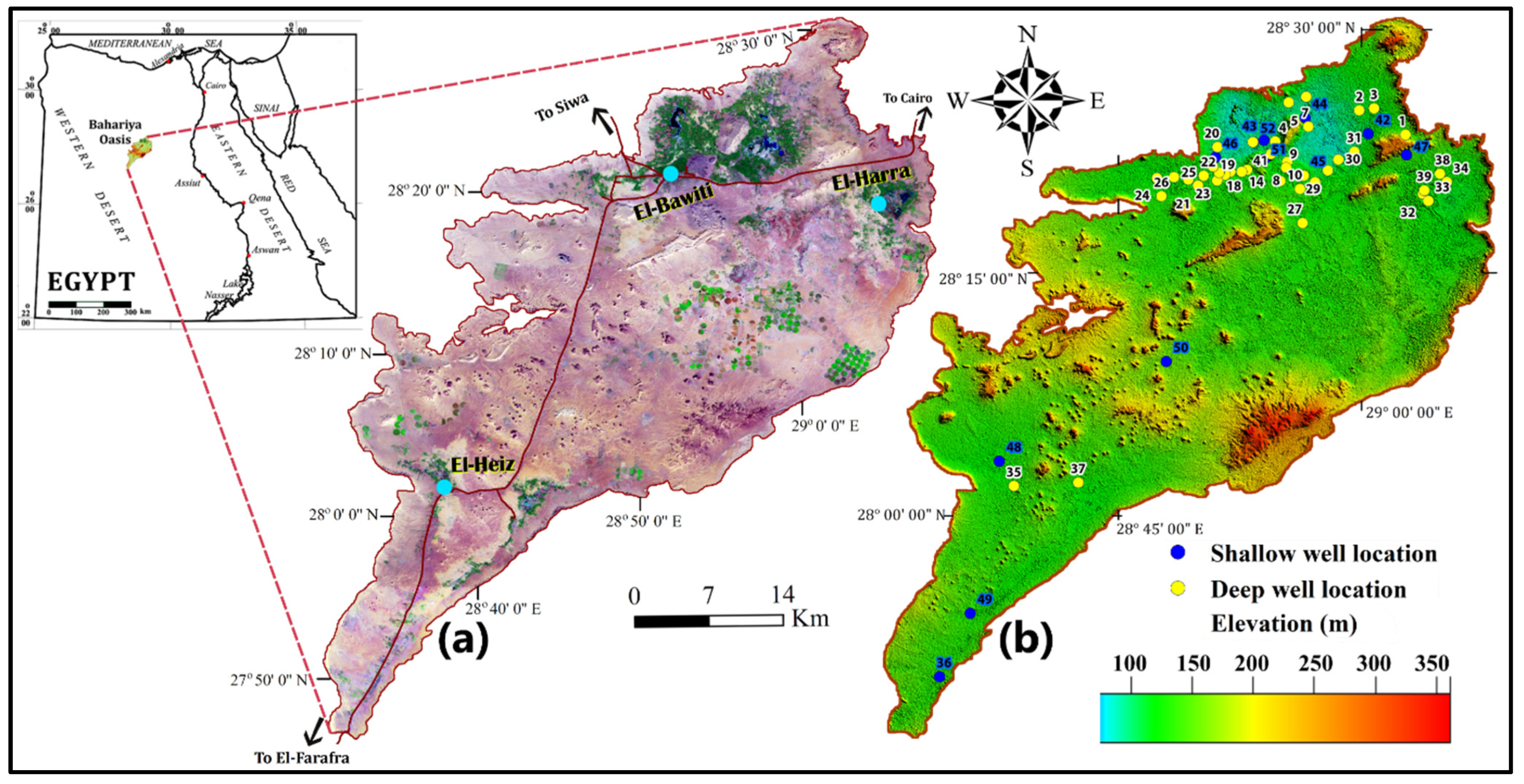

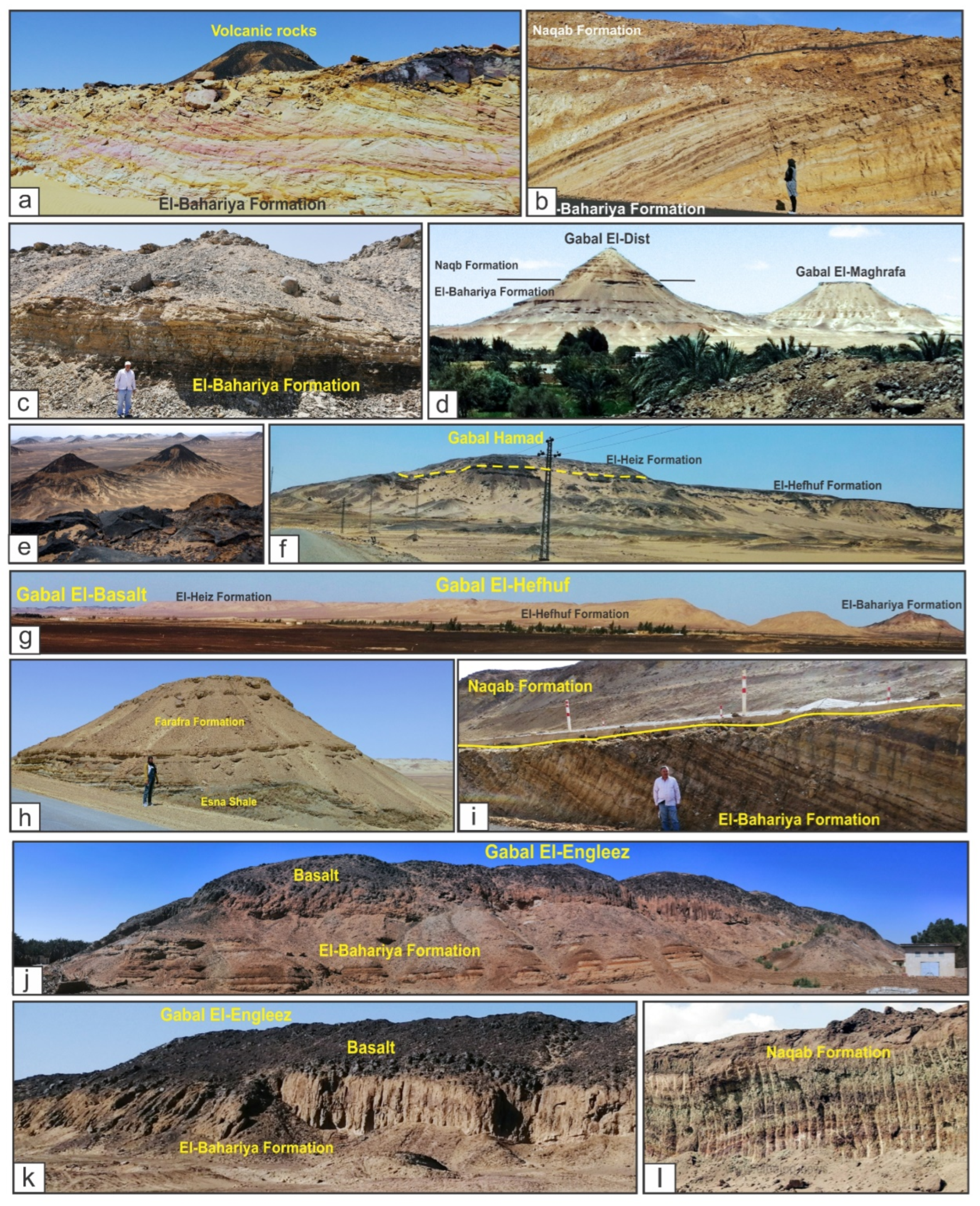

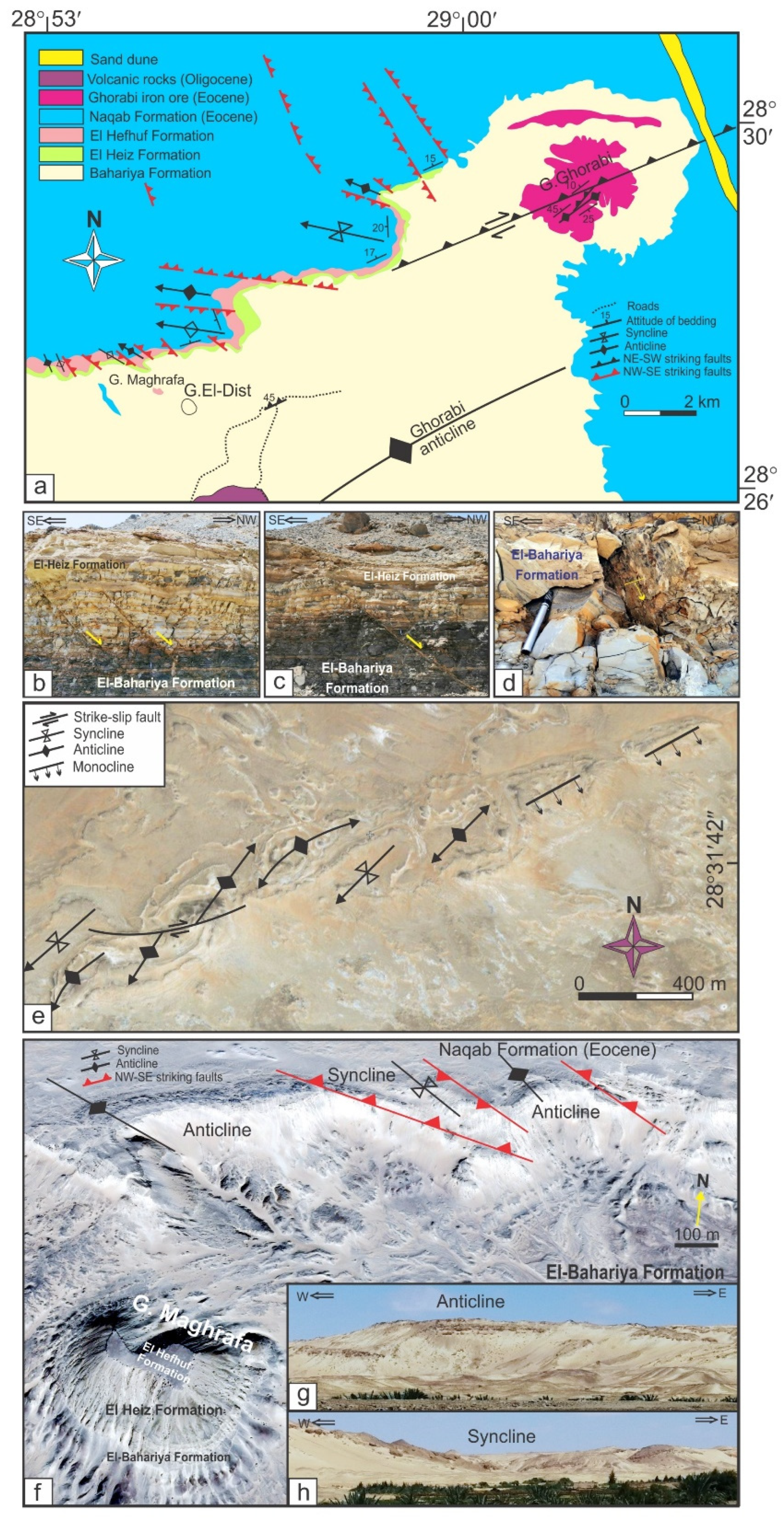

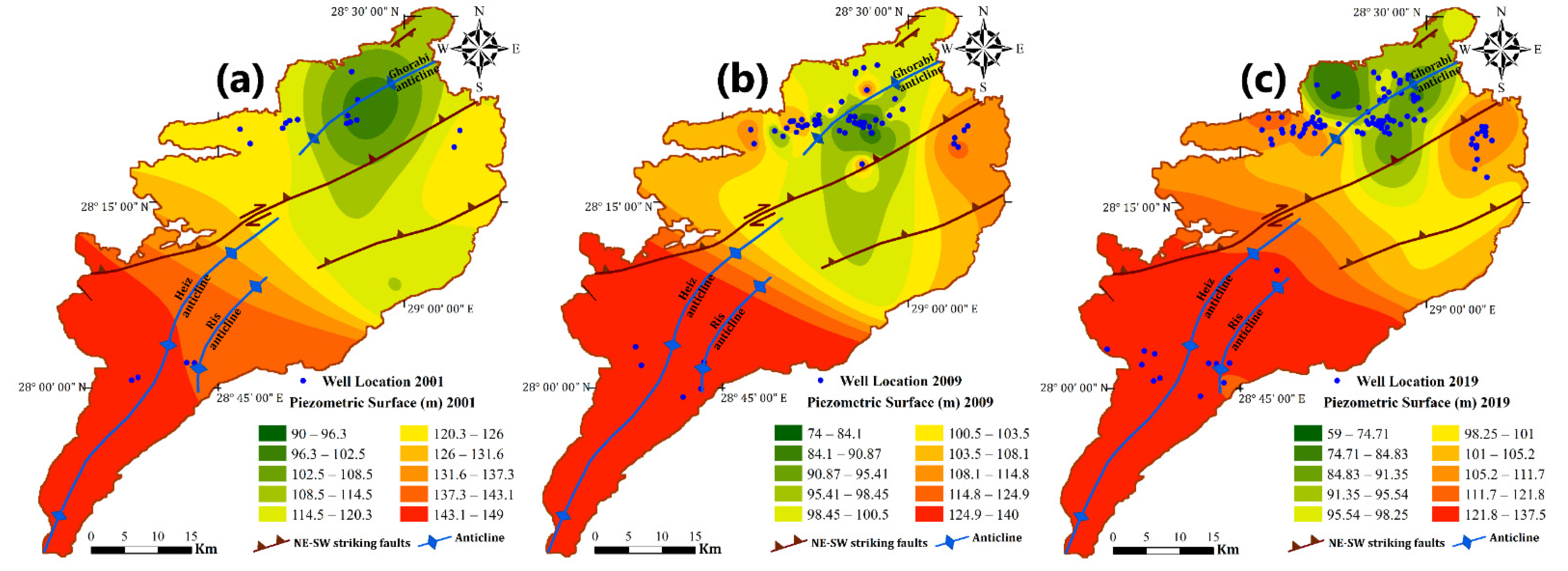
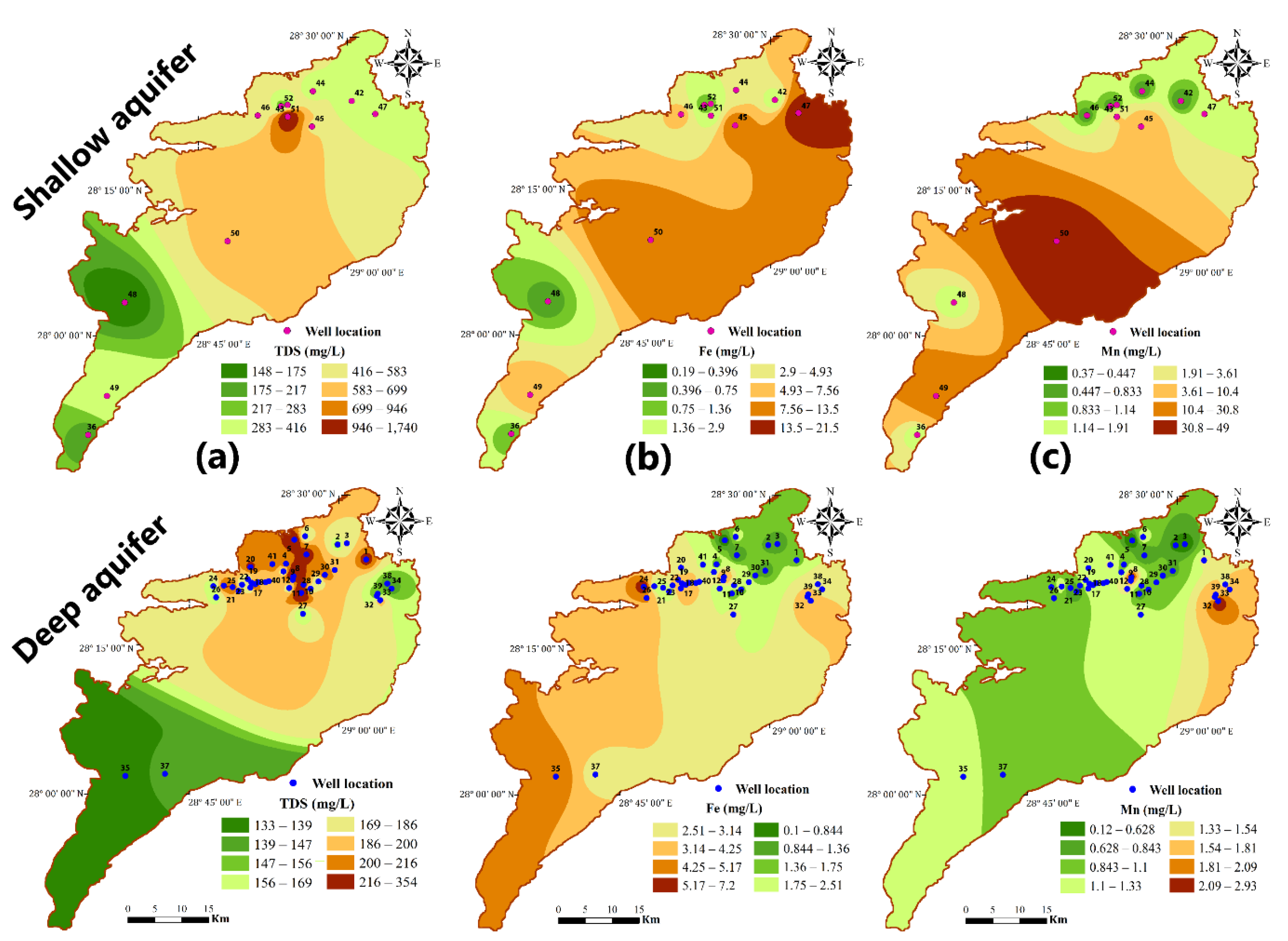

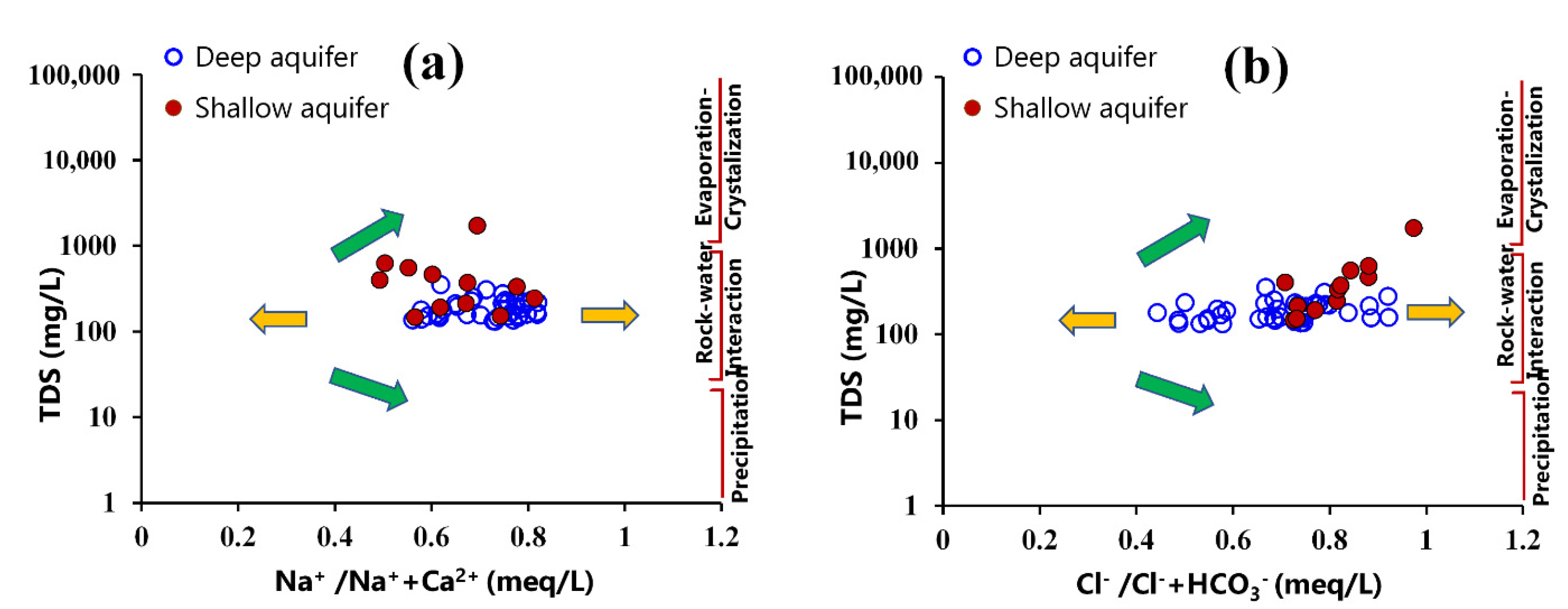
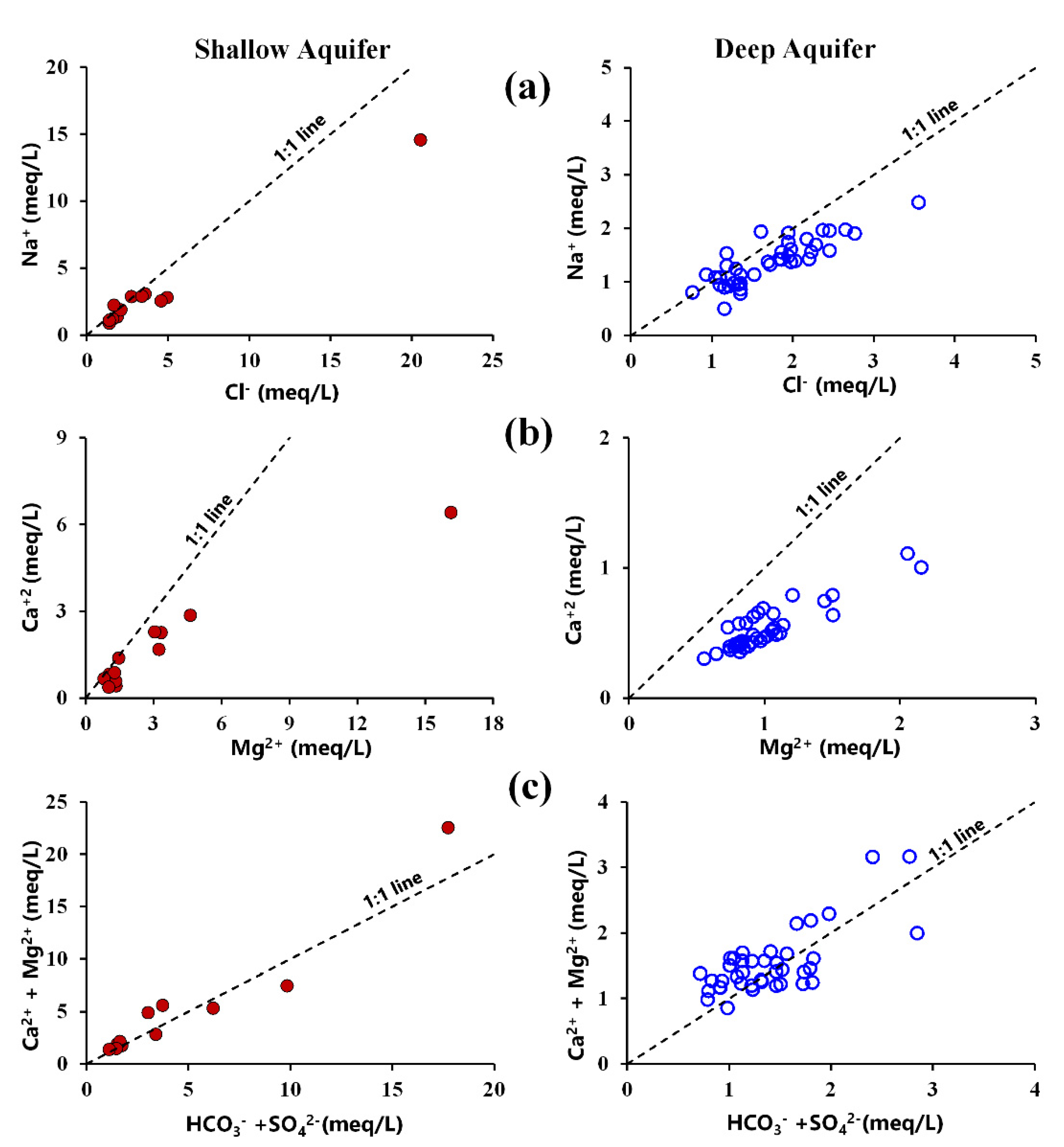
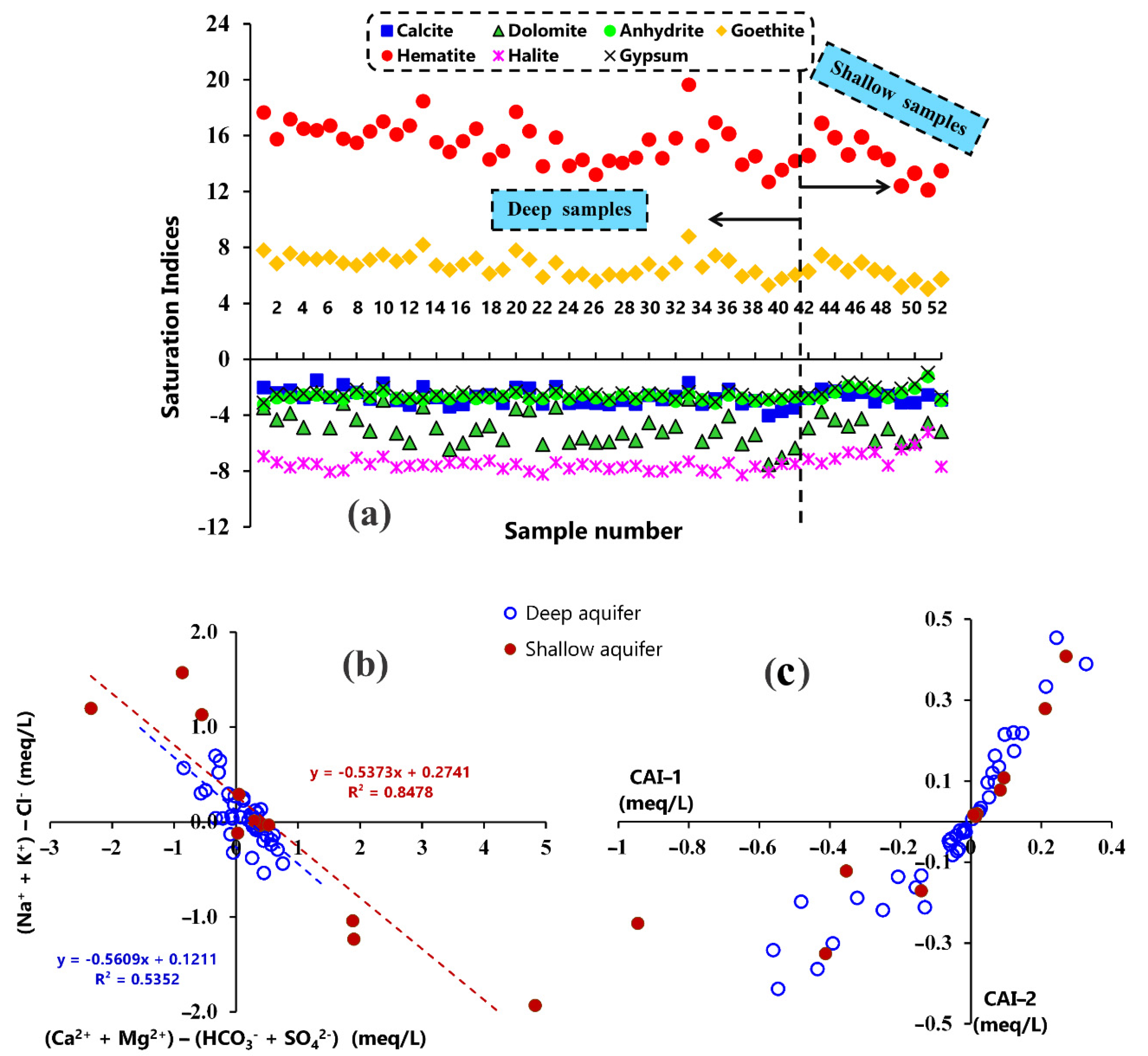
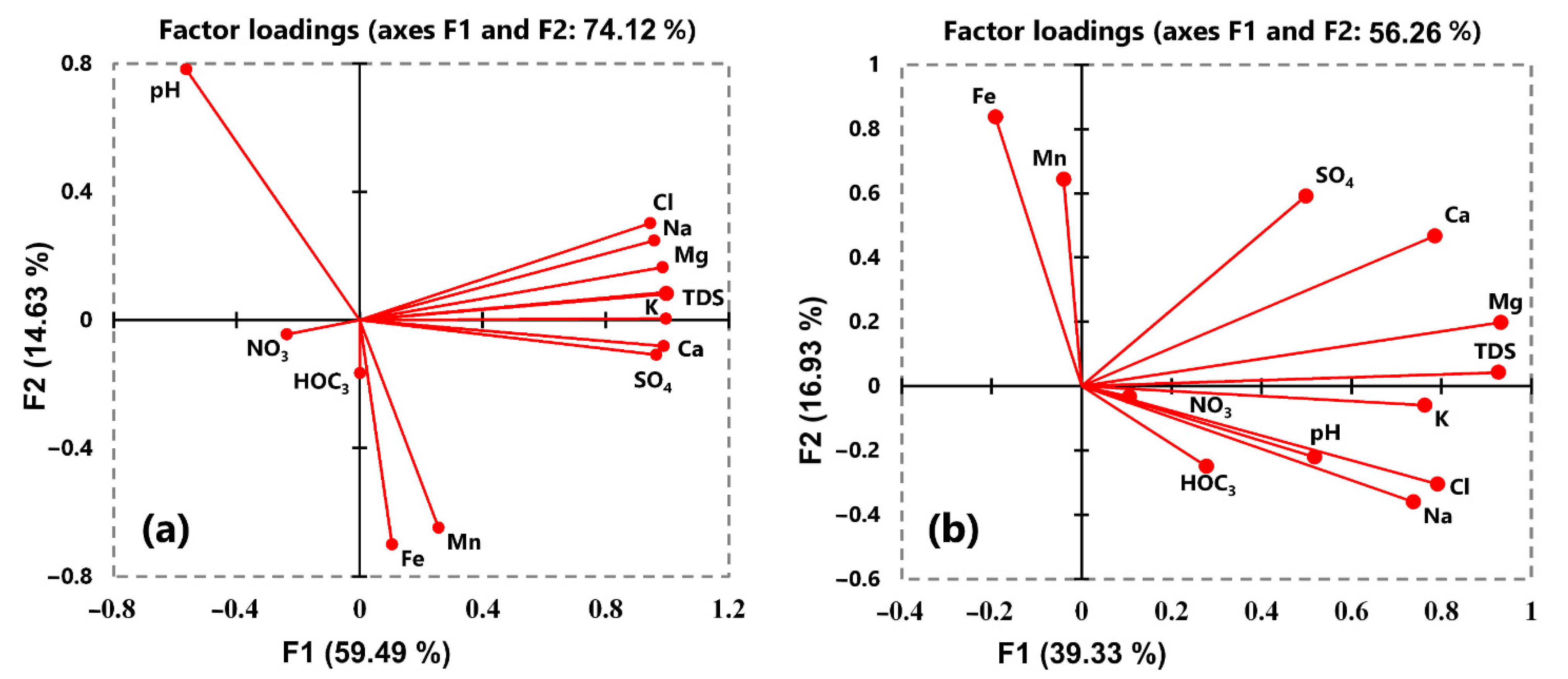
| Variable | Shallow-Aquifer Samples n = 12 Samples | Deep-Aquifer Samples n = 40 Samples | Acceptable Limits | ||||||
|---|---|---|---|---|---|---|---|---|---|
| Min. | Max. | Mean | St. dev. | Min. | Max. | Mean | St. dev. | (WHO 2011) | |
| TDS (mg/L) | 147.9 | 1740.0 | 455.3 | 434.0 | 133.0 | 354.0 | 189.4 | 50.6 | 1500 |
| EC (μ.S/cm) | 296.0 | 3530.0 | 916.2 | 881.3 | 267.0 | 708.0 | 380.0 | 98.9 | - |
| pH | 5.7 | 6.8 | 6.2 | 0.3 | 5.6 | 7.0 | 6.2 | 0.3 | 6.5–8.5 |
| Ca2+ | 7.7 | 128.7 | 34.6 | 33.9 | 6.1 | 22.2 | 10.6 | 3.5 | 200 |
| Mg2+ | 9.8 | 196.1 | 39.1 | 51.6 | 6.7 | 26.2 | 12.2 | 4.0 | 150 |
| Na+ | 20.1 | 334.7 | 71.6 | 84.8 | 11.6 | 57.2 | 31.8 | 9.7 | 200 |
| K+ | 11.5 | 158.3 | 39.6 | 40.6 | 6.9 | 26.2 | 15.4 | 5.3 | 30 |
| HCO3− | 28.0 | 56.0 | 37.0 | 8.3 | 6.0 | 98.0 | 46.9 | 21.7 | 300 |
| SO42− | 29.0 | 825.0 | 182.4 | 236.6 | 9.0 | 81.0 | 30.2 | 18.1 | 250 |
| Cl− | 49.0 | 728.0 | 146.8 | 188.1 | 27.0 | 126.0 | 61.3 | 21.0 | 250 |
| NO3− | 0.1 | 5.7 | 2.1 | 2.2 | 0.1 | 9.2 | 4.4 | 2.2 | 50 |
| Fe2+ | 0.2 | 21.5 | 5.6 | 6.8 | 0.1 | 7.2 | 2.7 | 1.7 | 0.2–0.3 |
| Mn2+ | 0.4 | 49.0 | 7.3 | 14.3 | 0.1 | 2.9 | 1.1 | 0.6 | 0.05–0.1 |
| Variables | TDS | pH | Ca | Mg | Na | K | HOC3 | SO4 | Cl | NO3 | Fe | Mn |
|---|---|---|---|---|---|---|---|---|---|---|---|---|
| TDS | 1 | |||||||||||
| pH | −0.49 | 1 | ||||||||||
| Ca | 0.98 | −0.61 | 1 | |||||||||
| Mg | 0.99 | −0.44 | 0.97 | 1 | ||||||||
| Na | 0.98 | −0.37 | 0.92 | 0.97 | 1 | |||||||
| K | 0.99 | −0.55 | 0.98 | 0.98 | 0.96 | 1 | ||||||
| HOC3 | 0.03 | −0.15 | 0.05 | −0.05 | 0.00 | −0.06 | 1 | |||||
| SO4 | 0.94 | −0.61 | 0.97 | 0.95 | 0.89 | 0.98 | −0.15 | 1 | ||||
| Cl | 0.97 | −0.32 | 0.91 | 0.97 | 0.99 | 0.94 | 0.03 | 0.86 | 1 | |||
| NO3 | −0.27 | 0.19 | −0.20 | −0.23 | −0.24 | −0.20 | −0.27 | −0.14 | −0.29 | 1 | ||
| Fe | 0.07 | −0.65 | 0.15 | −0.04 | −0.04 | 0.11 | 0.29 | 0.11 | −0.07 | 0.05 | 1 | |
| Mn | 0.19 | −0.62 | 0.33 | 0.16 | 0.02 | 0.27 | −0.15 | 0.44 | −0.02 | 0.04 | 0.38 | 1 |
| Variables | TDS | pH | Ca | Mg | Na | K | HOC3 | SO4 | Cl | NO3 | Fe | Mn |
|---|---|---|---|---|---|---|---|---|---|---|---|---|
| TDS | 1 | |||||||||||
| pH | 0.50 | 1 | ||||||||||
| Ca | 0.67 | 0.32 | 1 | |||||||||
| Mg | 0.83 | 0.49 | 0.89 | 1 | ||||||||
| Na | 0.67 | 0.37 | 0.31 | 0.54 | 1 | |||||||
| K | 0.74 | 0.40 | 0.57 | 0.67 | 0.56 | 1 | ||||||
| HOC3 | 0.14 | 0.09 | 0.25 | 0.26 | 0.41 | 0.21 | 1 | |||||
| SO4 | 0.45 | 0.19 | 0.75 | 0.67 | 0.13 | 0.30 | −0.08 | 1 | ||||
| Cl | 0.71 | 0.36 | 0.41 | 0.64 | 0.85 | 0.68 | 0.12 | 0.15 | 1 | |||
| NO3 | 0.14 | 0.07 | 0.19 | 0.12 | −0.06 | 0.04 | 0.04 | 0.05 | −0.13 | 1 | ||
| Fe | −0.14 | −0.41 | 0.24 | −0.06 | −0.38 | −0.15 | −0.04 | 0.34 | −0.39 | −0.08 | 1 | |
| Mn | 0.05 | −0.22 | 0.09 | 0.00 | −0.07 | −0.07 | −0.23 | 0.28 | −0.09 | −0.29 | 0.61 | 1 |
| Variable | F1 | F2 | F3 | Communality |
|---|---|---|---|---|
| TDS | 0.99 | 0.10 | −0.07 | 1.00 |
| pH | −0.58 | 0.77 | 0.07 | 0.94 |
| Ca2+ | 0.99 | −0.07 | −0.02 | 0.98 |
| Mg2+ | 0.98 | 0.18 | 0.03 | 1.00 |
| Na+ | 0.95 | 0.26 | −0.08 | 0.98 |
| K+ | 1.00 | 0.02 | 0.06 | 1.00 |
| HCO3− | 0.00 | −0.17 | −0.77 | 0.63 |
| SO42− | 0.97 | −0.09 | 0.24 | 1.00 |
| Cl− | 0.94 | 0.32 | −0.14 | 1.00 |
| NO3− | −0.23 | −0.05 | 0.32 | 0.16 |
| Fe2+ | 0.11 | −0.70 | −0.19 | 0.54 |
| Mn2+ | 0.27 | −0.64 | 0.35 | 0.61 |
| Eigenvalue | 7.13 | 1.76 | 0.95 | |
| Variability (%) | 59.5 | 14.6 | 7.9 | |
| Cumulative % | 59.5 | 74.1 | 82.1 |
| Variable | F1 | F2 | F3 | F4 | Communality |
|---|---|---|---|---|---|
| TDS | 0.89 | 0.05 | −0.13 | 0.01 | 0.81 |
| pH | 0.51 | −0.21 | −0.06 | 0.23 | 0.37 |
| Ca2+ | 0.79 | 0.48 | 0.23 | 0.21 | 0.95 |
| Mg2+ | 0.94 | 0.21 | 0.07 | 0.16 | 0.96 |
| Na+ | 0.75 | −0.35 | −0.07 | −0.38 | 0.83 |
| K+ | 0.76 | −0.05 | −0.06 | −0.04 | 0.58 |
| HCO3− | 0.31 | −0.24 | 0.85 | −0.36 | 1.00 |
| SO42− | 0.51 | 0.61 | −0.01 | 0.19 | 0.66 |
| Cl− | 0.80 | −0.30 | −0.32 | −0.27 | 0.91 |
| NO3− | 0.08 | −0.03 | 0.20 | 0.38 | 0.19 |
| Fe2+ | −0.20 | 0.84 | 0.16 | −0.25 | 0.83 |
| Mn2+ | −0.06 | 0.63 | −0.27 | −0.44 | 0.67 |
| Eigenvalue | 4.75 | 2.07 | 1.04 | 0.91 | |
| Variability (%) | 39.56 | 17.28 | 8.69 | 7.54 | |
| Cumulative % | 39.56 | 56.84 | 65.53 | 73.08 |
Publisher’s Note: MDPI stays neutral with regard to jurisdictional claims in published maps and institutional affiliations. |
© 2022 by the authors. Licensee MDPI, Basel, Switzerland. This article is an open access article distributed under the terms and conditions of the Creative Commons Attribution (CC BY) license (https://creativecommons.org/licenses/by/4.0/).
Share and Cite
Abd El-Wahed, M.; El-Horiny, M.M.; Ashmawy, M.; El Kereem, S.A. Multivariate Statistical Analysis and Structural Sovereignty for Geochemical Assessment and Groundwater Prevalence in Bahariya Oasis, Western Desert, Egypt. Sustainability 2022, 14, 6962. https://doi.org/10.3390/su14126962
Abd El-Wahed M, El-Horiny MM, Ashmawy M, El Kereem SA. Multivariate Statistical Analysis and Structural Sovereignty for Geochemical Assessment and Groundwater Prevalence in Bahariya Oasis, Western Desert, Egypt. Sustainability. 2022; 14(12):6962. https://doi.org/10.3390/su14126962
Chicago/Turabian StyleAbd El-Wahed, Mohamed, Mohamed M. El-Horiny, Mahmoud Ashmawy, and Samar Abd El Kereem. 2022. "Multivariate Statistical Analysis and Structural Sovereignty for Geochemical Assessment and Groundwater Prevalence in Bahariya Oasis, Western Desert, Egypt" Sustainability 14, no. 12: 6962. https://doi.org/10.3390/su14126962
APA StyleAbd El-Wahed, M., El-Horiny, M. M., Ashmawy, M., & El Kereem, S. A. (2022). Multivariate Statistical Analysis and Structural Sovereignty for Geochemical Assessment and Groundwater Prevalence in Bahariya Oasis, Western Desert, Egypt. Sustainability, 14(12), 6962. https://doi.org/10.3390/su14126962







